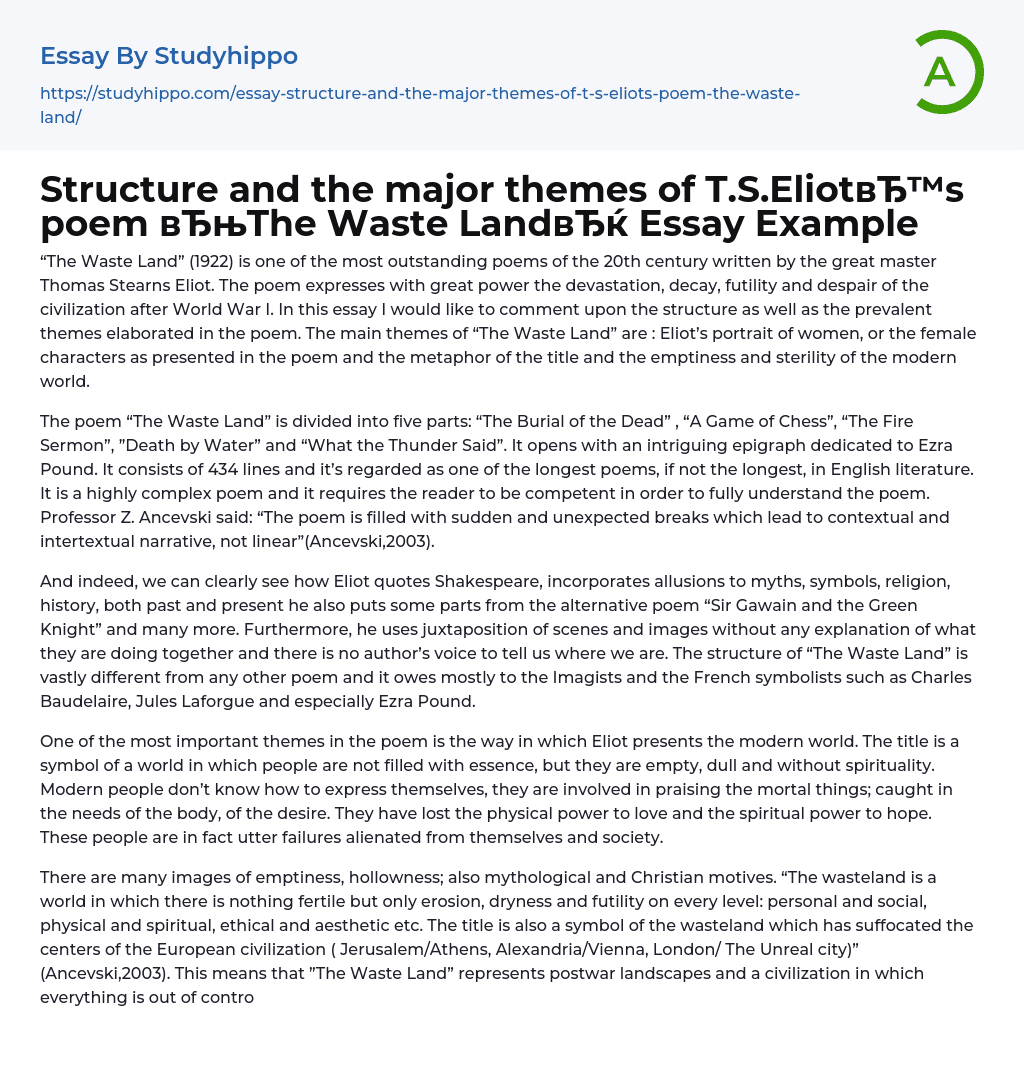

Structure and the major themes of T.S.Eliot’s poem “The Waste Land” Essay Example
“The Waste Land” (1922) is one of the most outstanding poems of the 20th century written by the great master Thomas Stearns Eliot. The poem expresses with great power the devastation, decay, futility and despair of the civilization after World War I. In this essay I would like to comment upon the structure as well as the prevalent themes elaborated in the poem. The main themes of “The Waste Land” are : Eliot’s portrait of women, or the female characters as presented in the poem and the metaphor of the title and the emptiness and sterility of the modern world.
The poem “The Waste Land” is divided into five parts: “The Burial of the Dead” , “A Game of Chess”, “The Fire Sermon”, ”Death by Water” and “What the Thunder Said”. It opens with an intriguing epigra
...ph dedicated to Ezra Pound. It consists of 434 lines and it’s regarded as one of the longest poems, if not the longest, in English literature. It is a highly complex poem and it requires the reader to be competent in order to fully understand the poem. Professor Z. Ancevski said: “The poem is filled with sudden and unexpected breaks which lead to contextual and intertextual narrative, not linear”(Ancevski,2003).
And indeed, we can clearly see how Eliot quotes Shakespeare, incorporates allusions to myths, symbols, religion, history, both past and present he also puts some parts from the alternative poem “Sir Gawain and the Green Knight” and many more. Furthermore, he uses juxtaposition of scenes and images without any explanation of what they are doing together and there is no author’s voice to tell us where
we are. The structure of “The Waste Land” is vastly different from any other poem and it owes mostly to the Imagists and the French symbolists such as Charles Baudelaire, Jules Laforgue and especially Ezra Pound.
One of the most important themes in the poem is the way in which Eliot presents the modern world. The title is a symbol of a world in which people are not filled with essence, but they are empty, dull and without spirituality. Modern people don’t know how to express themselves, they are involved in praising the mortal things; caught in the needs of the body, of the desire. They have lost the physical power to love and the spiritual power to hope. These people are in fact utter failures alienated from themselves and society.
There are many images of emptiness, hollowness; also mythological and Christian motives. “The wasteland is a world in which there is nothing fertile but only erosion, dryness and futility on every level: personal and social, physical and spiritual, ethical and aesthetic etc. The title is also a symbol of the wasteland which has suffocated the centers of the European civilization ( Jerusalem/Athens, Alexandria/Vienna, London/ The Unreal city)” (Ancevski,2003). This means that ”The Waste Land” represents postwar landscapes and a civilization in which everything is out of control.
Another important theme is Eliot’s portrayal of female characters. He presents women whose main wish is to die, for instance he employs the myth of Sibyl who was unhappy because she has the chance to live long life but not to have permanent beauty and youth; and for this reason she wish for death.
Another important female character is Madame Sosotris – a fortune-telling fraud. People who are stacked in their tedious routines of everyday life are prone to listen to this charlatan, since they did not know what to do with their lives.
Certainly, the most important character is “the typist” and the scene of her sexual intercourse with “the young man carbuncular”. This sexual act has no passion, no love or not even the slightest wish to connect spiritually with this man. The man leaves her apartment and she does not even seem to notice or care. This points to the fact that modern man are stucked in their biological needs. All in all, this epic poem is so powerful because it changed the way modern poetry was written. It is so important because it incorporates our modern civilization and the hollow people after World War I.
- Book Summary essays
- Metaphor essays
- Reader essays
- Rhyme essays
- Literary devices essays
- Villain essays
- Books essays
- Genre essays
- Literary Criticism essays
- Writer essays
- Protagonist essays
- Simile essays
- Poem essays
- Book Report essays
- Book Review essays
- Greek Mythology essays
- Plot essays
- Tragic Hero essays
- Coming of Age essays
- Play essays
- Rhetoric essays
- Rhetorical Question essays
- Translation essays
- Understanding essays
- Reason essays
- Character essays
- Letter essays
- American Literature essays
- Literature Review essays
- Utopia essays
- Poetry Analysis essays
- Dante's Inferno essays
- Between The World and Me essays
- Incidents in The Life of a Slave Girl essays
- Flowers for Algernon essays
- Myth essays
- Everyday Use essays
- Boo Radley essays
- Genesis essays
- Richard iii essays
- Alice in Wonderland essays
- On the road essays
- Ozymandias essays
- The Nightingale essays
- Holden Caulfield essays
- Animal Farm essays
- 1984 essays
- A Hanging essays
- Shooting An Elephant essays
- A Tale Of Two Cities essays



